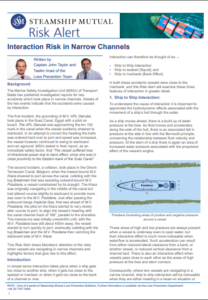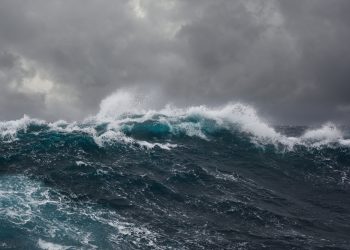Steamship Mutual issued a Risk Alert describing ship to ship interaction, squat, bank effects while focuses on causes and preventative actions.
Following the investigation reports of Marine Safety Investigation Unit (MSIU) of Transport Malta, for two accidents which took place in narrow channels, Steamship Mutual paid attention to the importance of properly understanding and appreciating the phenomenon of interaction when navigating in a narrow channels.
In fact, the risk alert refers to the the grounding of M.V. APL Danube which took place in the Suez Canal and the collision incident the M.V. Klara.
Following the above examples, the Risk Alert draws Members’ attention to the risks when vessels are navigating in narrow channels and highlights factors that give rise to this effect.
For the records, in simple terms interaction takes place when a ship gets too close to another ship, when it gets too close to the seabed or riverbed, or when it gets too close to the bank of a channel or river.
Interaction can therefore be thought of as:
- Ship to Ship Interaction
To understand the cause of interaction it is important to appreciate the hydrodynamic effects associated with the movement of a ship’s hull through the water.
- Ship to seabed (Squat)
This occurs when a vessel proceeds too fast in shallow waters. In squat, the vessel’s turning circle increases as the effectiveness of rudder helm decreases and stopping distances and stopping times increase.
- Ship to riverbank (Bank Effect)
As the ship navigates in a narrow channel, the water between the bow and the nearer bank builds up a high pressure resulting in the bow being pushed away from the riverbank, the phenomenon is called Bank Cushion.
Although, every vessel’s manoeuvring characteristics are individual to itself. Every vessel also behaves differently in shallow waters and this can be dependent on the manoeuvring characteristics of the vessel and be affected by the design of the hull, her draught and trim in relation to the available depth of navigable water, type of equipment installed on board (overall engine power and rudder type), loading condition of vessel (i.e. ballast or laden) and whether the vessel has a list or is upright.
All these conditions can impact the vessel’s manoeuvrability and the bridge team need to be aware of their vessel specific characteristics in order that they can take timely and appropriate actions to reduce the effect of interaction.
Navigation in narrow channels should be carried out at slow speed with due regard to the local hydrographical conditions. A vessel’s speed should be appropriate for the depth of water, such as to adequately maintain control, with sufficient contingent power available to aid the rudder if necessary.
Explore more herebelow





























































